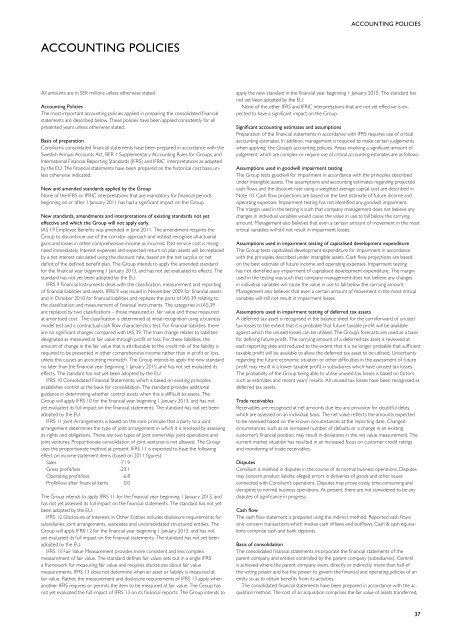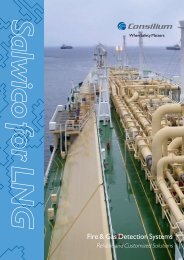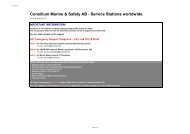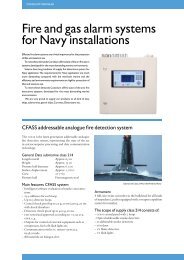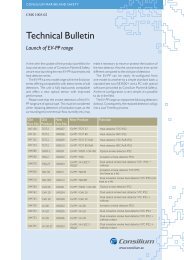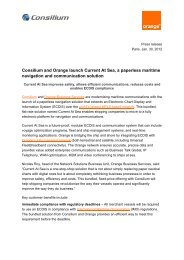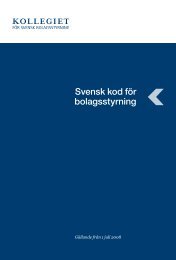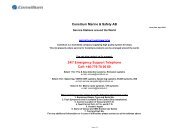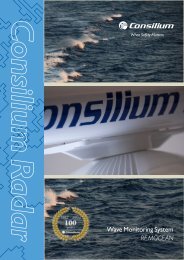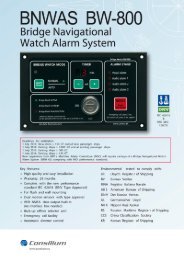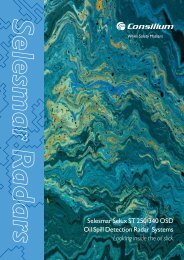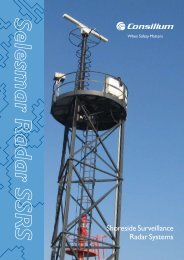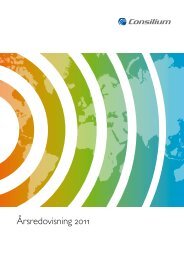Annual Report in English - Consilium
Annual Report in English - Consilium
Annual Report in English - Consilium
You also want an ePaper? Increase the reach of your titles
YUMPU automatically turns print PDFs into web optimized ePapers that Google loves.
ACCountInG PolICIes<br />
All amounts are <strong>in</strong> seK millions unless otherwise stated.<br />
Account<strong>in</strong>g Policies<br />
The most important account<strong>in</strong>g policies applied <strong>in</strong> prepar<strong>in</strong>g the consolidated f<strong>in</strong>ancial<br />
statements are described below. These policies have been applied consistently for all<br />
presented years unless otherwise stated.<br />
Basis of preparation<br />
<strong>Consilium</strong>’s consolidated f<strong>in</strong>ancial statements have been prepared <strong>in</strong> accordance with the<br />
swedish <strong>Annual</strong> Accounts Act, RfR 1 supplementary Account<strong>in</strong>g Rules for Groups, and<br />
<strong>in</strong>ternational f<strong>in</strong>ancial <strong>Report</strong><strong>in</strong>g standards (ifRs) and ifRiC <strong>in</strong>terpretations as adopted<br />
by the eu. The f<strong>in</strong>ancial statements have been prepared on the historical cost basis unless<br />
otherwise <strong>in</strong>dicated.<br />
new and amended standards applied by the Group<br />
none of the ifRs or ifRiC <strong>in</strong>terpretations that are mandatory for f<strong>in</strong>ancial periods<br />
beg<strong>in</strong>n<strong>in</strong>g on or after 1 January 2011 has had a significant impact on the Group.<br />
new standards, amendments and <strong>in</strong>terpretations of exist<strong>in</strong>g standards not yet<br />
effective and which the Group will not apply early.<br />
iAs 19 employee Benefits was amended <strong>in</strong> June 2011. The amendment requires the<br />
Group to discont<strong>in</strong>ue use of the corridor approach and <strong>in</strong>stead recognise all actuarial<br />
ga<strong>in</strong>s and losses <strong>in</strong> other comprehensive <strong>in</strong>come as <strong>in</strong>curred. past service cost is recognised<br />
immediately. <strong>in</strong>terest expenses and expected return on plan assets will be replaced<br />
by a net <strong>in</strong>terest calculated us<strong>in</strong>g the discount rate, based on the net surplus or net<br />
deficit of the def<strong>in</strong>ed benefit plan. The Group <strong>in</strong>tends to apply the amended standard<br />
for the f<strong>in</strong>ancial year beg<strong>in</strong>n<strong>in</strong>g 1 January 2013, and has not yet evaluated its effects. The<br />
standard has not yet been adopted by the eu.<br />
ifRs 9 f<strong>in</strong>ancial <strong>in</strong>struments deals with the classification, measurement and report<strong>in</strong>g<br />
of f<strong>in</strong>ancial liabilities and assets. ifRs 9 was issued <strong>in</strong> november 2009 for f<strong>in</strong>ancial assets<br />
and <strong>in</strong> october 2010 for f<strong>in</strong>ancial liabilities and replaces the parts of iAs 39 relat<strong>in</strong>g to<br />
the classification and measurement of f<strong>in</strong>ancial <strong>in</strong>struments. The categories <strong>in</strong> iAs 39<br />
are replaced by two classifications – those measured at fair value and those measured<br />
at amortised cost. The classification is determ<strong>in</strong>ed at <strong>in</strong>itial recognition us<strong>in</strong>g a bus<strong>in</strong>ess<br />
model test and a contractual cash flow characteristics test. for f<strong>in</strong>ancial liabilities, there<br />
are no significant changes compared with iAs 39. The ma<strong>in</strong> change relates to liabilities<br />
designated as measured at fair value through profit or loss. for these liabilities, the<br />
amount of change <strong>in</strong> the fair value that is attributable to the credit risk of the liability is<br />
required to be presented <strong>in</strong> other comprehensive <strong>in</strong>come rather than <strong>in</strong> profit or loss,<br />
unless this causes an account<strong>in</strong>g mismatch. The Group <strong>in</strong>tends to apply the new standard<br />
no later than the f<strong>in</strong>ancial year beg<strong>in</strong>n<strong>in</strong>g 1 January 2015, and has not yet evaluated its<br />
effects. The standard has not yet been adopted by the eu.<br />
ifRs 10 Consolidated f<strong>in</strong>ancial statements, which is based on exist<strong>in</strong>g pr<strong>in</strong>ciples,<br />
establishes control as the basis for consolidation. The standard provides additional<br />
guidance <strong>in</strong> determ<strong>in</strong><strong>in</strong>g whether control exists when this is difficult to assess. The<br />
Group will apply ifRs 10 for the f<strong>in</strong>ancial year beg<strong>in</strong>n<strong>in</strong>g 1 January 2013, and has not<br />
yet evaluated its full impact on the f<strong>in</strong>ancial statements. The standard has not yet been<br />
adopted by the eu.<br />
ifRs 11 Jo<strong>in</strong>t Arrangements is based on the core pr<strong>in</strong>ciple that a party to a jo<strong>in</strong>t<br />
arrangement determ<strong>in</strong>es the type of jo<strong>in</strong>t arrangement <strong>in</strong> which it is <strong>in</strong>volved by assess<strong>in</strong>g<br />
its rights and obligations. There are two types of jo<strong>in</strong>t ownership: jo<strong>in</strong>t operations and<br />
jo<strong>in</strong>t ventures. proportionate consolidation of jo<strong>in</strong>t ventures is not allowed. The Group<br />
uses the proportionate method at present. ifRs 11 is expected to have the follow<strong>in</strong>g<br />
effect on <strong>in</strong>come statement items (based on 2011 figures):<br />
sales -71.9<br />
Gross profit/loss -23.1<br />
operat<strong>in</strong>g profit/loss -6.8<br />
profit/loss after f<strong>in</strong>ancial items 0.0<br />
The Group <strong>in</strong>tends to apply ifRs 11 for the f<strong>in</strong>ancial year beg<strong>in</strong>n<strong>in</strong>g 1 January 2013, and<br />
has not yet assessed its full impact on the f<strong>in</strong>ancial statements. The standard has not yet<br />
been adopted by the eu.<br />
ifRs 12 disclosure of <strong>in</strong>terests <strong>in</strong> other entities <strong>in</strong>cludes disclosure requirements for<br />
subsidiaries, jo<strong>in</strong>t arrangements, associates and unconsolidated structured entities. The<br />
Group will apply ifRs 12 for the f<strong>in</strong>ancial year beg<strong>in</strong>n<strong>in</strong>g 1 January 2013, and has not<br />
yet evaluated its full impact on the f<strong>in</strong>ancial statements. The standard has not yet been<br />
adopted by the eu.<br />
ifRs 13 fair Value measurement provides more consistent and less complex<br />
measurement of fair value. The standard def<strong>in</strong>es fair value, sets out <strong>in</strong> a s<strong>in</strong>gle ifRs<br />
a framework for measur<strong>in</strong>g fair value and requires disclosures about fair value<br />
measurements. ifRs 13 does not determ<strong>in</strong>e when an asset or liability is measured at<br />
fair value. Rather, the measurement and disclosure requirements of ifRs 13 apply when<br />
another ifRs requires or permits the item to be measured at fair value. The Group has<br />
not yet evaluated the full impact of ifRs 13 on its f<strong>in</strong>ancial reports. The Group <strong>in</strong>tends to<br />
ACCountInG PolICIes<br />
apply the new standard <strong>in</strong> the f<strong>in</strong>ancial year beg<strong>in</strong>n<strong>in</strong>g 1 January 2015. The standard has<br />
not yet been adopted by the eu.<br />
none of the other ifRs and ifRiC <strong>in</strong>terpretations that are not yet effective is expected<br />
to have a significant impact on the Group.<br />
significant account<strong>in</strong>g estimates and assumptions<br />
preparation of the f<strong>in</strong>ancial statements <strong>in</strong> accordance with ifRs requires use of critical<br />
account<strong>in</strong>g estimates. <strong>in</strong> addition, management is required to make certa<strong>in</strong> judgements<br />
when apply<strong>in</strong>g the Group’s account<strong>in</strong>g policies. Areas <strong>in</strong>volv<strong>in</strong>g a significant amount of<br />
judgement, which are complex or require use of critical account<strong>in</strong>g estimates are as follows.<br />
Assumptions used <strong>in</strong> goodwill impairment test<strong>in</strong>g<br />
The Group tests goodwill for impairment <strong>in</strong> accordance with the pr<strong>in</strong>ciples described<br />
under <strong>in</strong>tangible assets. The assumptions and account<strong>in</strong>g estimates regard<strong>in</strong>g projected<br />
cash flows and the discount rate us<strong>in</strong>g a weighted average capital cost are described <strong>in</strong><br />
note 10. Cash flow projections are based on the best estimate of future <strong>in</strong>come and<br />
operat<strong>in</strong>g expenses. impairment test<strong>in</strong>g has not identified any goodwill impairment.<br />
The marg<strong>in</strong> used <strong>in</strong> the test<strong>in</strong>g is such that company management does not believe any<br />
changes <strong>in</strong> <strong>in</strong>dividual variables would cause the value <strong>in</strong> use to fall below the carry<strong>in</strong>g<br />
amount. management also believes that even a certa<strong>in</strong> amount of movement <strong>in</strong> the most<br />
critical variables will still not result <strong>in</strong> impairment losses.<br />
Assumptions used <strong>in</strong> impairment test<strong>in</strong>g of capitalised development expenditure<br />
The Group tests capitalised development expenditure for impairment <strong>in</strong> accordance<br />
with the pr<strong>in</strong>ciples described under <strong>in</strong>tangible assets. Cash flow projections are based<br />
on the best estimate of future <strong>in</strong>come and operat<strong>in</strong>g expenses. impairment test<strong>in</strong>g<br />
has not identified any impairment of capitalised development expenditure. The marg<strong>in</strong><br />
used <strong>in</strong> the test<strong>in</strong>g was such that company management does not believe any changes<br />
<strong>in</strong> <strong>in</strong>dividual variables will cause the value <strong>in</strong> use to fall below the carry<strong>in</strong>g amount.<br />
management also believes that even a certa<strong>in</strong> amount of movement <strong>in</strong> the most critical<br />
variables will still not result <strong>in</strong> impairment losses.<br />
Assumptions used <strong>in</strong> impairment test<strong>in</strong>g of deferred tax assets<br />
A deferred tax asset is recognised <strong>in</strong> the balance sheet for the carryforward of unused<br />
tax losses to the extent that it is probable that future taxable profit will be available<br />
aga<strong>in</strong>st which the unused losses can be utilised. The Group’s forecasts are used as a basis<br />
for def<strong>in</strong><strong>in</strong>g future profit. The carry<strong>in</strong>g amount of a deferred tax asset is reviewed at<br />
each report<strong>in</strong>g date and reduced to the extent that it is no longer probable that sufficient<br />
taxable profit will be available to allow the deferred tax asset to be utilised. uncerta<strong>in</strong>ty<br />
regard<strong>in</strong>g the future economic situation or other difficulties <strong>in</strong> the assessment of future<br />
profit may result <strong>in</strong> a lower taxable profit <strong>in</strong> subsidiaries which have unused tax losses.<br />
The probability of the Group be<strong>in</strong>g able to utilise unused tax losses is based on factors<br />
such as estimates and recent years’ results. All unused tax losses have been recognised as<br />
deferred tax assets.<br />
trade receivables<br />
Receivables are recognised at net amounts due less any provision for doubtful debts,<br />
which are assessed on an <strong>in</strong>dividual basis. The net value reflects the amounts expected<br />
to be received based on the known circumstances at the report<strong>in</strong>g date. Changed<br />
circumstances, such as an <strong>in</strong>creased number of defaults or a change <strong>in</strong> an exist<strong>in</strong>g<br />
customer’s f<strong>in</strong>ancial position, may result <strong>in</strong> deviations <strong>in</strong> the net value measurement. The<br />
current market situation has resulted <strong>in</strong> an <strong>in</strong>creased focus on customer credit rat<strong>in</strong>gs<br />
and monitor<strong>in</strong>g of trade receivables.<br />
Disputes<br />
<strong>Consilium</strong> is <strong>in</strong>volved <strong>in</strong> disputes <strong>in</strong> the course of its normal bus<strong>in</strong>ess operations. disputes<br />
may concern product liability, alleged errors <strong>in</strong> deliveries of goods and other issues<br />
connected with <strong>Consilium</strong>’s operations. disputes may prove costly, time-consum<strong>in</strong>g and<br />
disruptive to normal bus<strong>in</strong>ess operations. At present, there are not considered to be any<br />
disputes of significance <strong>in</strong> progress.<br />
Cash flow<br />
The cash flow statement is prepared us<strong>in</strong>g the <strong>in</strong>direct method. <strong>Report</strong>ed cash flows<br />
only concern transactions which <strong>in</strong>volve cash <strong>in</strong>flows and outflows. Cash & cash equivalents<br />
comprise cash and bank deposits.<br />
Basis of consolidation<br />
The consolidated f<strong>in</strong>ancial statements <strong>in</strong>corporate the f<strong>in</strong>ancial statements of the<br />
parent company and entities controlled by the parent company (subsidiaries). Control<br />
is achieved where the parent company owns, directly or <strong>in</strong>directly, more than half of<br />
the vot<strong>in</strong>g power and has the power to govern the f<strong>in</strong>ancial and operat<strong>in</strong>g policies of an<br />
entity so as to obta<strong>in</strong> benefits from its activities.<br />
The consolidated f<strong>in</strong>ancial statements have been prepared <strong>in</strong> accordance with the acquisition<br />
method. The cost of an acquisition comprises the fair value of assets transferred,<br />
37


